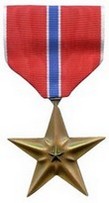Gil Hodges
Ballplayers Decorated in Combat
| Date and Place of Birth: | April 4, 1924 Princeton, IN |
| Date and Place of Death: | April 2, 1972 West Palm Beach, FL |
| Baseball Experience: | Major League |
| Position: | First Base |
| Rank: | Sergeant |
| Military Unit: | 16th Anti-Aircraft Artillery Battalion US Marine Corps |
| Area Served: | Pacific Theater of Operation |
Gilbert R. “Gil” Hodges was born on April 4, 1924, in Princeton,
Indiana, and grew up in nearby Petersburg. He was a four-sport athlete
at Petersburg High School and turned down an offer from the Detroit
Tigers to attend St. Joseph’s College in Rensselaer, Indiana, where he
played basketball and baseball.
As a sophomore he was lured by the Brooklyn Dodgers and signed with the
team in 1943. Without playing a game in the minors, Hodges made his
major league debut on the very last day of the season – October 3 – in a
6-1 loss against the Reds. Playing third base, he made three plate
appearances, walking once and striking out twice.
Eleven days later, Hodges entered service with the Marine Corps. He took
basic training at Camp Elliot in San Diego, and was promoted to private
first class. He was then assigned to Company A, Infantry Battalion, for
eight weeks of training as a rifleman using the Browning Automatic Rifle
(BAR) - a light machine-gun that weighed around 20 pounds that was used
to support riflemen in an attack. In February 1944, Hodges joined the
44th Replacement Battalion, awaiting deployment overseas. On March 5,
1944, he boarded the SS Santa Monica to join the 5th Amphibious Corps in
Hawaii.
Baseball wasn't far from Hodges' mind and at the Transient Center, near Honolulu, where he was stationed, he formed a baseball team. In April 1944, Hodges joined the newly formed 16th Anti-Aircraft Artillery (AAA) Battalion, and a transport ship took him to the Hawaiian island of Kauai, where the battalion would train, and he would have a further opportunity to play baseball for the battalion team.
On December 22, 1944, the battalion left Hawaii for the island of Tinian, a Pacific island which had been captured from the Japanese during the summer. They arrived there in early January and Hodges was now a corporal.
In April 1945, Hodges landed with the assault echelon at Okinawa and was assigned to his battalion's operations and intelligence section as asistant to Colonel Merchant. Just getting ashore at Okinawa was an experience in itself, as Hodges explained in a letter to his family:
“We arrived here [Okinawa] the first of April and things really cut loose. We were always having air attacks and the ships were really knocking down the planes. It’s just like being tied down when you’re on board a ship because you can’t do a thing but just stand there and wait for something to happen. One Jap plane, a Zero, came circling around where we were anchored and when everyone saw it they really cut loose. I don’t see how it was possible for him to escape with so much firing being done at that time. He was the plane that really gave all of us a scare. He started to pull away from the firing and then he got hit and started circling around, then into a suicide dive. He started coming down and boy he was really moving. He crashed on the bow of another LST not very far from our ship and exploded. I don’t know how many got hurt but I’m sure there were quite a few. Well, that’s just one incident and I don’t want to go into any other at the present time because I could probably sit here and write all day and still not be through.”
Sergeant Hodges was awarded the Bronze Star for his excellent work on
Okinawa. The citation states that he "was entrusted with the
safeguarding and stenographic preparation of highly classified
documents" through "extensive periods of enemy aerial alerts and
extensive bombing attacks."
Hodges remained on Okinawa until October 1945. Playing baseball occupied
some of his free time, but he started smoking "to have something to do
sitting in those [fox] holes."
On February 3, 1946, Sergeant Gil Hodges was honorably discharged from
the Marine Corps. Aged 22, he returned to the Brooklyn Dodgers'
organization. He was converted to a catcher and played for the Newport
News Dodgers of the Class B Piedmont League that year, batting .278 in
129 games. In 1947, he joined Brooklyn for 28 games as a back-up catcher
and batted just .156, then underwent another transition the following
year, moving from catcher to first base and allowing Jackie Robinson to
shift over to second.
Hodges remained the Dodgers regular first baseman until drafted by the
New York Mets in the 1961 expansion draft. During those years he was an
eight-time all-star and three-time Gold Glove winner, and appeared in
seven World Series.
In 1963, at the age of 39, and after getting off to a slow start with
the Mets, Hodges was traded to the Washington Senators and managed the
team for the next five seasons. Back with the Mets in 1968, he led them
to their “Miracle Mets” season of 1969, defeating the Baltimore Orioles
four-games-to-one in the World Series.
Gil Hodges was still at the helm of the Mets when he suffered a fatal
heart attack during spring training at West Palm Beach, Florida, on
April 2, 1972 - two days short of his 48th birthday. He had just enjoyed
a round of golf with coaches Joe Pignatano, Eddie Yost and Rube Walker.
Since his death, Hodges has had a great deal of support for enshrinement
in the Hall of Fame but has always fallen short. Most recently, in 2008,
he was named on 28 of the 64 ballots, 20 shy of the 75% needed for
election.
Date Added January 26, 2018
Can you add more information to this biography and help make it the best online resource for this player? Contact us by email
Read Baseball's Greatest Sacrifice Through The Years - an online year-by-year account of military related deaths of ballplayers
Baseball's Greatest Sacrifice is associated with Baseball Almanac
Baseball's Greatest Sacrifice is proud to be sponsored by


